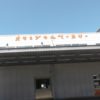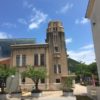鳥取で電動アシストの自転車で・・・。
大阪から鳥取まで、今回は高速バスにて 朝の7時に乗って 鳥取に着いたのが10時ぐらいだったか、とりあえず3時間ぐらいはかかった。鳥取の駅前に着くと、駅前のビルっていうか、ステーションビル 駅のビルの左端のほうに第2駐輪場があって そこで自転車のレンタルをしているので

■入る前の芝生から撮った!

■表入口から撮った!

■中の部屋です。

■この階段が面白い。うすい?

■各部屋・・・。
仁風閣に行ってみる、必見!。
仁風閣に行く道も簡単で とりあえず、駅前の大きな通りを山のほうに行くとつきあたりを左のほうっていうか お城跡があって お堀をわたっってもう見えてるって感じの所にありますが・・・。

■サンルーム、ベランダからみた風景

■この階段です。

■部屋です。
藩主池田家の別邸ではあるが・・・。

■階段上から、近代建築は階段です。

■裏庭の風景。
”るろうに剣心”の撮影場所として
でも、当時というか明治維新から大正にかけて 大日本帝国?時代の建物って感じで

■夕方の表玄関入口

■るろうに剣心で使われてる。
I went to “Jinpukaku” in Tottori! A pretty famous building that was used in the Rurouni Kenshin movie.
In Tottori with an electric assist bicycle.
From Osaka to Tottori, this time I took a highway bus at 7:00 in the morning and arrived at Tottori around 10:00, so it took about 3 hours. When I arrived in front of Tottori station, there was a second bicycle parking lot on the left side of the building in front of the station, or rather, the building in front of the station building. However, he becomes addicted to this again… Electric bikes are really fun. The only downside is that my butt hurts because I run long distances in no time, and if the road is bad, it hurts even more… I rented a bicycle for the time being and went to “Jinpukaku”.
Visit Jinpukaku, a must-see!
The road to Jinpukaku is also easy.For the time being, if you go to the mountain on the main street in front of the station, there is a castle ruin on the left at the end, and you can already see it after crossing the moat. There is… It’s white, so it stands out and you can see it right away. This is “Jinpukaku”. It is an important cultural property of the country, but it is a beautiful Western-style building for the time being. Is this Jinpukaku part of the Tottori clan? It is said that this villa belonged to the Ikeda family, the feudal lord of Inaba.It was the work of Tokuma Katayama, who was famous as an architect at the time.Was he a popular architect at the time, or was he a government official? Is it reluctant to do so, or is it supervising?The name I often hear is “Nara Museum”. This Jinpukaku is also splendid.
Although it is a villa of the Ikeda family, the feudal lord.
The Ikeda family began with “Tsuneoki Ikeda”, a retainer of Nobunaga Oda, whose son joined the Tokugawa side.As a result, the Ikeda family came to occupy Okayama, Tottori, and Awaji. In Tottori, Nagayoshi, the son of Tsuneoki Ikeda, became the lord of the Inaba Tottori Domain, and his descendant, Nakahiro Ikeda, became the lord of the Tottori Domain in the Meiji period. However, it was designed as a lodging house for the royal family. In fact, when it was first completed, the future Emperor Taisho stayed there, and Heihachiro Togo, who accompanied him on that occasion, apparently named it Jinpukaku. After that, it became the property of Tottori City and was used as a guest house and a public hall.
As a filming location for “Rurouni Kenshin”
But at that time, from the Meiji Restoration to the Taisho era, the Empire of Japan? It feels like a building from the period, and it’s a Western-style building with a bit of a western flair, and it’s a Romanesque-style building that was common in the “Rokumeikan” era at the time. It seems that it is also used in movies, such as Hiromi Go’s “Maihime” and more recently Takeru Sato’s “Rurouni Kenshin”. So I checked the “Rurouni” movie, and it was certainly used, but it was a little different, and it was absurdly wide. Is this actually a CG composition in the video? He appears in many scenes in Jinpukaku, a gathering place for unscrupulous wealthy merchants in the Meiji era after the Meiji Restoration, where Kenshin and others board… After all, the building is white and very beautiful. It feels perfect for the movie.

